When I started sewing, around ten years ago, I did not know about the sewing blogosphere and indie patterns didn’t really exist yet. Instead, my world was filled with Burdastyle magazines and their many cheap patterns with minimalistic instructions and no seam allowances. Oh, how many times I realized that I should have finished my seams when it was already too late… So, even though my bookshelf has since been filled with vintage Vogue and Butterick reprints on one side, and Deer&Doe, Colette and friends on the other side, I did manage to bring with me to the US two dozens of Burda magazines (let’s not mention the enormous box that I left at my parent’s place…). A few weeks ago, I was reminded of the amazingness of Burda in a not-so-amazing way, when the french-speaking sewing blogosphere burst into flames at the reveal of the latest plagiarism scandal: some of the patterns of the French brand Aime comme Marie were strangely identical to existing patterns, amongst which a Burda shirt from 2009 (see the story in pictures here). In the discussions that followed, some people started questioning indie brands as a whole: why should we pay so much money for indie patterns when we can have twenty patterns for half the price in a Burda magazine? Well, let’s take a rain check on the question for now, I want to show you my new Burda skirt…
All this talk about Burda reminded me of the december 2011 issue, in which I had at the time spotted a nice pleated leather skirt. The suede version made by Juliette had convinced me of the pattern’s potential, and I had bought fabric for it, a weird synthetic mustard mystery something that had a very appealing price (1€ / meter). And then I made something else, then forgot, then three years later the fabric was still in my stash when I remembered the pattern.
So I took out and unfolded the pattern sheet in front of my half-amazed half-terrified boyfriend… Because if you have never seen a Burdastyle magazine sheet, this is what it looks like… to a colorblind person:
So much for accessibility..!
But anyway, Burda patterns and I, we’re buddies, so it took me a couple sessions over the weekend and then this skirt was one.
I really like the result, especially how the pleats look with this fabric that is very different from the one used for the magazine version. However… it is super short! I did not forget to add the hem allowance, it’s just that because it is more poofy in this fabric, it looks very different from the straight leather version, so I should have added 4 more inches or so. Worn with tights, it still works (as long as I remember not to bend over). The skirt is lined, and has pockets in the side seams.
An interesting thing with this pattern is that, unlike most pleated skirts I have seen, the back does not have pleats but it A-line. I think it’s a great feature! As much as I love pleats on the front of skirts, I have to admit that on the back they tend to add a lot of volume. So, to fit my hips in the A-line back and lining of the skirt, I had to grade from a size 36 at the waist to a size 40 at the hips.
Instead of pleats, the back had darts. I did the best I could, but the darts and the zipper don’t look so neat, there is a lot of puckering going on. Let’s blame it on the fabric.
The lining is done in a super soft gingham cotton, that you might get a glimpse from in the pictures. The pockets are gingham too.
I understitched the seam allowances to the pockets so that the pockets stay in place, but from certain angles you can still see the lining. Looking back at it, I guess I should have made the pockets in the outer fabric, but it’s okay, it looks more fun that way.
After making the skirt I started to feel very unsure about its color, that seemed very dull and khaki-beigish under artificial lights. However, under natural lights, it lights up and turns into this pretty mustard color, which I think goes well with my usual palette of purple and teal.
In the end I am really glad with this skirt, and it revived my love for Burdastyle magazines. I think it’s a good example of why one should look beyond the presentation pictures and pay more attention to technical drawings: in the leather fabric, it looks straight, rigid, edgy, and not really my style. But in this fabric it’s a high-waisted retro skirt! Something that helps is that I only marked the pleats at the top: I thought I might end up marking them all the way, but the feedback on Instagram was quasi-unanimous, and I’m glad I listened because the skirt has much more volume this way.
Now let’s get back to the question from the beginning of this post. As I was saying, there has been this debate on the french-speaking sewing blogosphere about Burda patterns versus indie patterns, something I think echoes in some ways the Big 4 vs. indie patterns discussions that take place on this side of the pond (in Europe, without Jo Ann’s sales, Big 4 patterns are often more expensive than indie patterns, so Burda is in the lead for offering variety and cheap prices). Basically people are starting to be annoyed by the constant flow of shiny new indies and the fact that everyone ends up making the same thing, and voices are raising against indie pattern brands (too expensive, marketing over quality, etc.). I’ve been feeling some of this too, and that’s why I’ve been diving back into my old Burda collection. I have to say, the case of Burda is special in that there is just no comparison between the quality of experience you get from making a good indie pattern (<3 Deer&Doe) or a Big 4 pattern rather than a random pattern from a Burda magazine : the tracing part that leaves you with PTSD, the lack of instructions, the need to add seam allowances... Plus I feel like being able to see so many versions of the same indie pattern can be a big help, both for design choices and for technical difficulties. How do you feel about all this? Have you ever made something from the Burdastyle magazines?
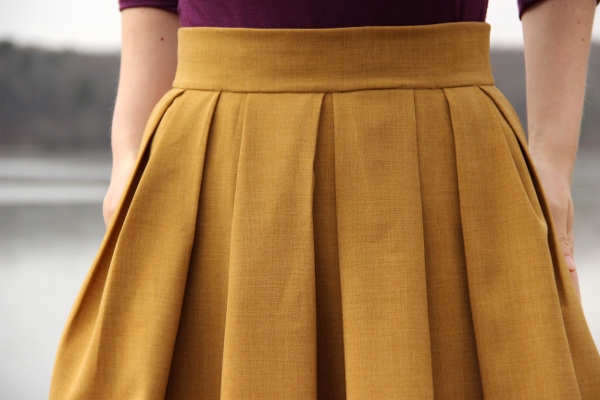
Mustard Skirt
Skirt 124 – Burda 12/2011 (available here)
Size 36 – 40
Mystery fabric from Stop Tissus in Paris
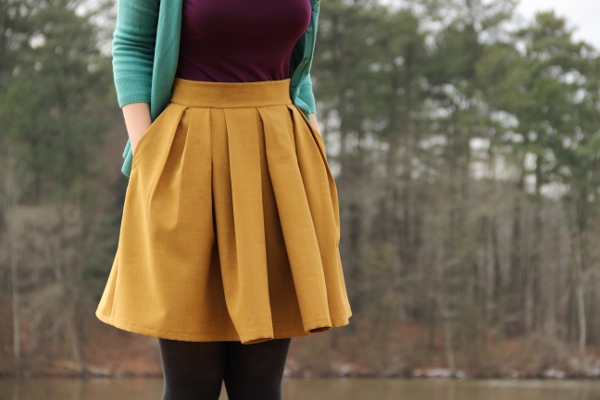
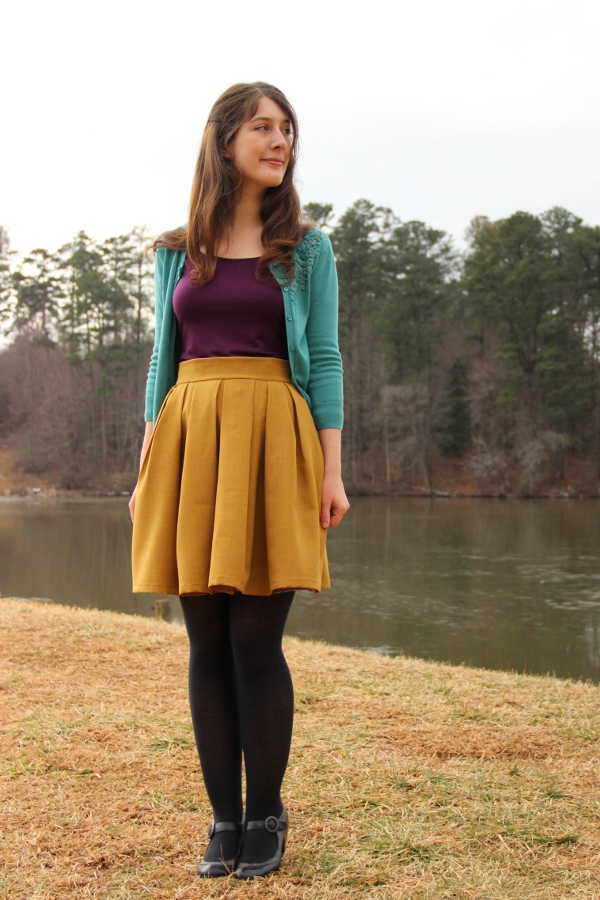

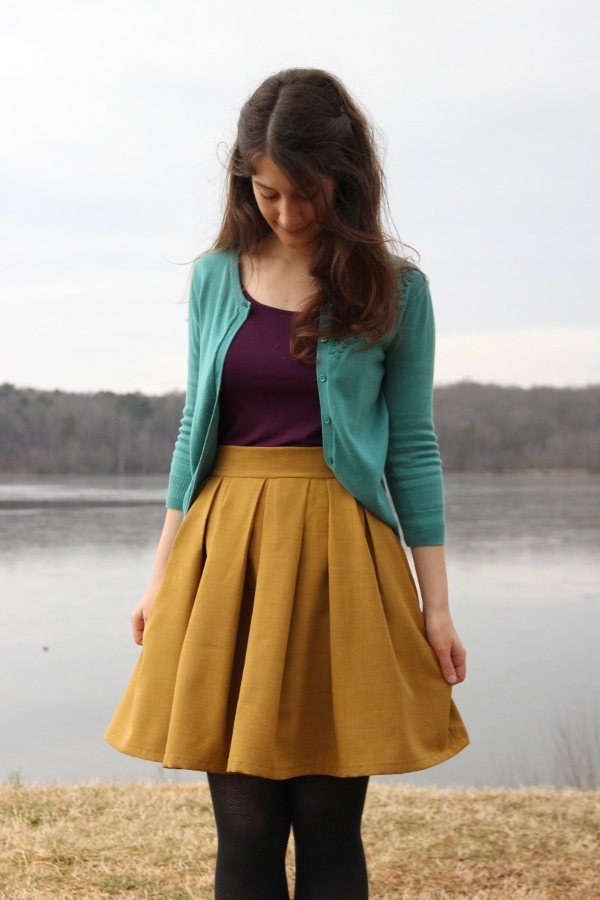
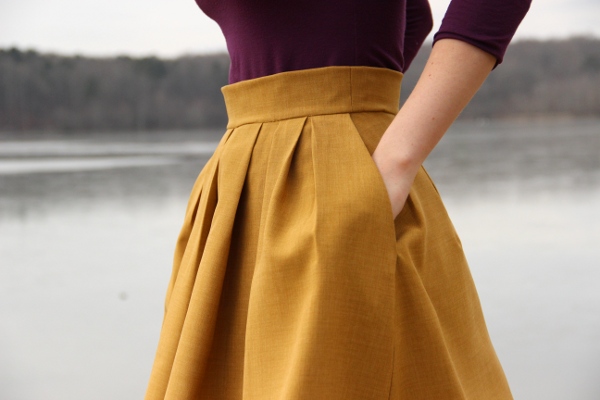
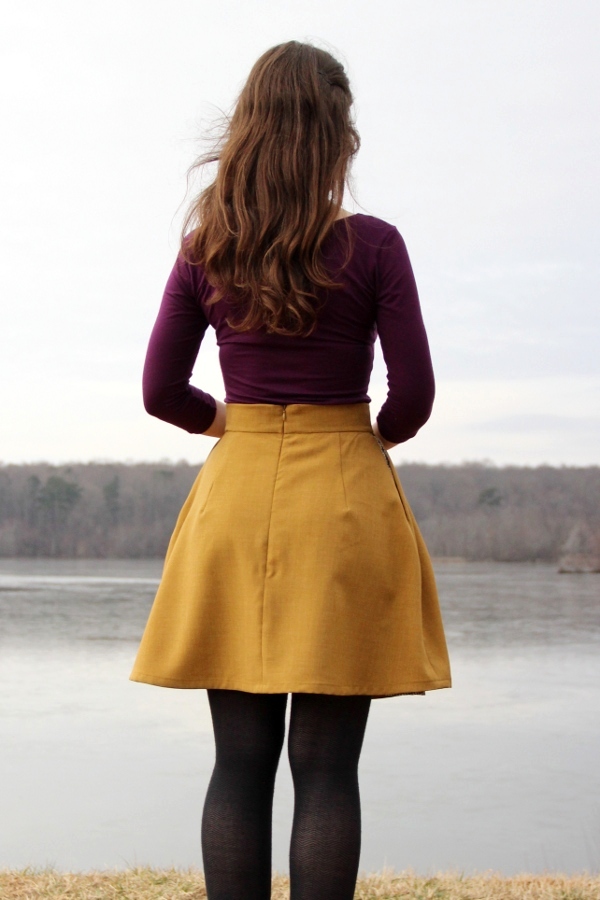
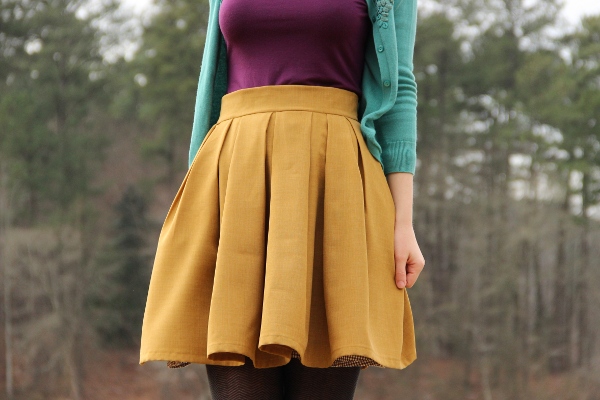
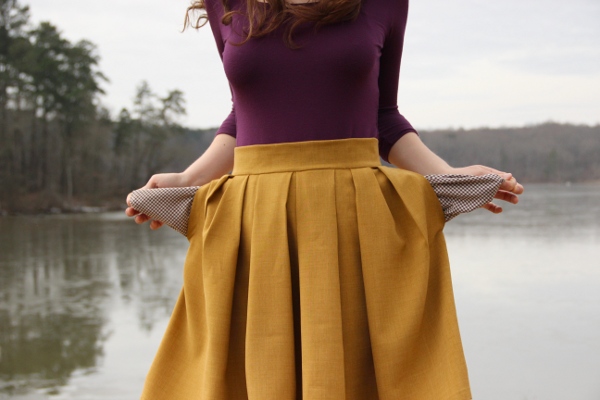
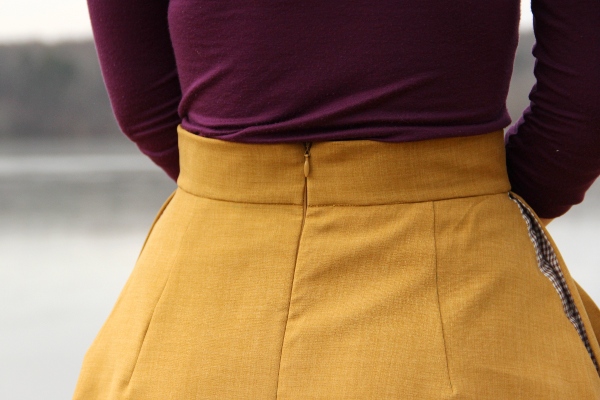
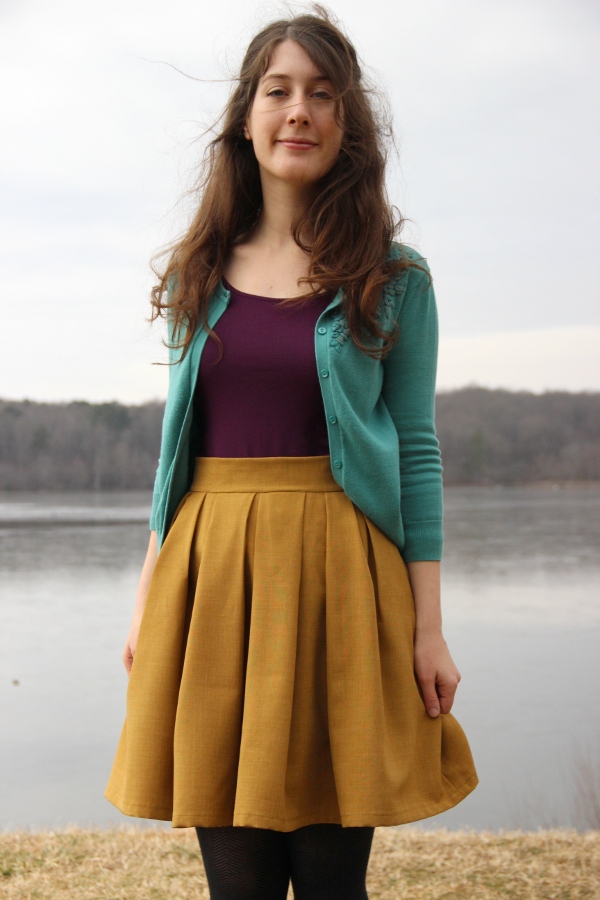
Such a lovely skirt. I have several Burdas in my pattern stash and I’m literally petrified of opening them. I purchased them in JoAnn’s but they sit & collect dust.
SN: I just finished a Butterick box pleated skirt too & I had loads of issues. I’m not really sure how I ended up with the actual pleats done. Can you describe how you accomplished yours?
So here’s how I proceed: I fold the fabric on itself, right sides together, so that the marks/notches meet, and I put a pin in both layers where the marks are. Then I fold the fabric pleat on the right or left depending of the arrow direction, I flatten it and I add several pins (or baste if I’m very motivated or if it’s a box pleat), then I remove the first pin (as it is hidden between layers it would be too hard to remove when sewing). I do this for each pleat individually, starting with the smallest and ending with the largest ones, then I baste everything.
I love Burda, I actually have this issue so it’s nice to see it made up to look so cute and vintage! Definitely pinning to remind me of this patterns potential 🙂
I feel like with indie patterns you’re paying for the whole package, which includes all the time spent providing free high quality blog content (I especially feel this way about Colette Patterns whose blog I love, but it holds true to many other indie pattern companies as well). I feel like in cases like that I don’t mind paying bit extra for a pattern (no patterns not big 4, not Burda are really available cheap here in Toronto Canada so there’s that too). That said, I am really choosy about which ones I buy, only committing to ones I love 100% 🙂
You’re very right. I’m getting quite used to the hand-holding of indie patterns and the photo and video sewalongs now, sometimes when sewing Burda I would really like to be able to search for more information when one line in the instruction is confusing, but I can’t!
I really like the colour of your skirt!
I sew almost exclusively from Burda patterns – I just can’t afford indie patterns. I don’t buy every single issue of Burda magazine either. I try to figure out which patterns might be useful for me and then decide if they’re worth buying. There are many repetitions in Burdamagazines, anyways so I’m usually able to find what I need in my stash (or do some simple redrafting).
I don’t mind tracing at all and for me the lack of seam allowances is an advantage – I can decide if I want 1 cm or 2 cm allowance for a project I’m currently tackling.
Whereas it’s admirable how much work and attention indie pattern designers put into their patterns, sometimes the designs seem so simple that I can easily recreate them from my TNTs at home. For example the Coco dress from Tilly and the Buttons – I love it, but I knew I would need an SBA anyways, so I just redrafted my go to pattern for a knit top, which already featured an SBA. I didn’t need to assemble the pdf pattern, saved quite a lot of money and was able to sew a similar dress that fit extremely well without having to fiddle with making a muslin or any additional alterations.
I agree, there are a lot of repetitions in Burda magazines! I was buying it regularly for a few years, then I had a subscription for a year, and now when I look at the new issue every month either I don’t see any pattern that I like or they look a lot like ones I already have in the old issues, so I haven’t really bought a new issue in a while. For the seam allowances, I’m torn. I made a shirt once from a fabric that had a very complicated chevrons+dots pattern, and the lack of seam allowance of the Burda pattern I used was super convenient to precisely match all the lines across the sides and front of the shirt, but in general I like when patterns have seam allowances because when I have to add them sometimes I am not very precise and I add or remove several millimeters to the pieces, and when there’s a lot of seaming it can lead to problems with the construction or fit.
I love this skirt and I think the length suits you very well. What annoys me with burda is that it’s so hard to see the pattern, because of the fabric choice (too much print), the styling, the photograph,… It sometimes just takes a pin on pinterest or a blogger to really show the beauty of the pattern and then it’s often too late to find the burda. And of course the repeat of patterns
I agree! What is frustrating with this is that often by the time I see the pattern made by another blogger and I become completely obsessed with making it, I can’t find the magazine anymore. I know you can buy the patterns individually on burdastyle but my strategy up to here has been “buying all the magazines just in case one pattern turns out to be a hidden gem a few years later”… erm
What a lovely skirt and that after 3 years. I do like Burda patterns, but also KNIP, Vogue and Maison Victor, but I also draft my own patterns. I’ve sewn a couple of Indie patterns. If I would have to say which one works better for me the big ones (Burda, Vogue, KNIP and Maison Victor) or the Indie I probably prefer the big ones. Tracing the patterns is something I don’t mind. It gives me the opportunity to measure the pattern and make alteration. And the lack of seam allowances: I use a geo-triangle and dressmakers chalk.
Besides the discussion of copying patterns like ACM seemed to be have done I see many Indie patterns that look almost identical like the big ones. When I’m abroad I always look for the sewing magazines and over the years I’ve found some nice magazines: Manequim, Female, Lady Bouttique.
Thanks for your comment! It’s always interesting to hear about the habits of other sewers. I have never tried Maison Victor but I keep seeing very good reviews, I should get started!
Lovely skirt 🙂
I live in Europe, Hungary, so so far I’ve bought only 2 indie patterns (bras). I like Burda because the price – you may not sew all the patterns but for 5 Euros it’s insanely cheap comparing to indie.
However I’m thinking about purchasing some indie patterns but right now I eventually try to develop my skills in drafting basic slopers and drafting clothes by myself.
Butterick, SImplicity— the shipping cost is too much to purchase them (the shipping cost almost equal with the price:( )
So back to the issue, I know that most of the Burda patterns are not suitable for me but some of them are really good. I don’t mind tracing and I don’t mind the lack of SA – it’s what I’m used to.
[…] navy chiffon dress and Liberty fabric dress • 7 skirts: Chardon, Brume, Mabel (portée 2 fois), jupe moutarde, jupe en vichy, Fumeterre and Zéphyr (not blogged yet) • 6 tops: Ondée (worn twice, not […]